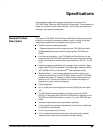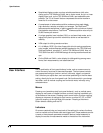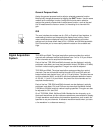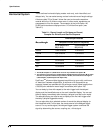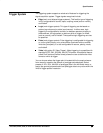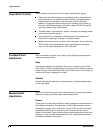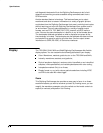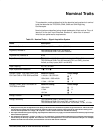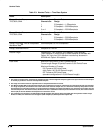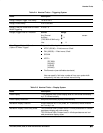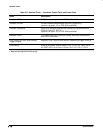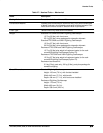
Specifications
TDS 520A, 524A, 540A, & 544A Performance Verification
Both H Bar and V Bar cursors can also be used to make absolute measure-
ments; that is measurements relative to a defined level or event. For the
H Bars, either cursor can be selected to read out its voltage with respect to
any channels ground reference level. For the V Bars, it’s time with respect to
the trigger point (event) of the acquisition, and the cursors can control the
portion of the waveform on which automatic measurements are made.
For time measurements, units can be either seconds or Hertz (for 1/time).
When the video trigger option installed (Option 05), the video line number can
be selected using the vertical cursors. IRE amplitude (NTSC) can be mea-
sured using the horizontal cursors with or without the video trigger option
installed.
Measure
Measure can automatically extract parameters from the signal input to the
Digitizing Oscilloscope. Any four out of the more than 20 parameters available
can be displayed to the screen. The waveform parameters are measured
continuously with the results updated on-screen as the Digitizing Oscilloscope
continues to acquire waveforms.
Digital Signal Processing (DSP)
An important component of the multiprocessor architecture of this Digitizing
Oscilloscope is Tektronix’s proprietary digital signal processor, the DSP. This
dedicated processor supports advanced analysis of your waveforms when
doing such compute-intensive tasks as interpolation, waveform math, and
signal averaging. It also teams with a custom display system to deliver spe-
cialized display modes (See
Display
, later
in this description.)
Acquired waveforms may be saved in any of four nonvolatile REF (reference)
memories or, if available, on a 3.5 inch, DOS 3.3-or-later compatible disk. The
disk is standard on the TDS 524A and 544A. It is available as option 1F on
the 520A and 540A. Any or all of the saved waveforms may be displayed for
comparison with the waveforms being currently acquired.
The source and destination of waveforms to be saved may be chosen. As-
signment can be made to save any of the four channels to any REF memory
or to move a stored reference from one REF memory to another. Reference
waveforms may also be written into a REF memory location via the GPIB
interface.
The Digitizing Oscilloscope is fully controllable and capable of sending and
receiving waveforms over the GPIB interface (IEEE Std 488.1–1987/IEEE Std
488.2–1987 standard). This feature makes the instrument ideal for making
automated measurements in a production or research and development
environment that calls for repetitive data taking. Self-compensation and
Storage and I/O





